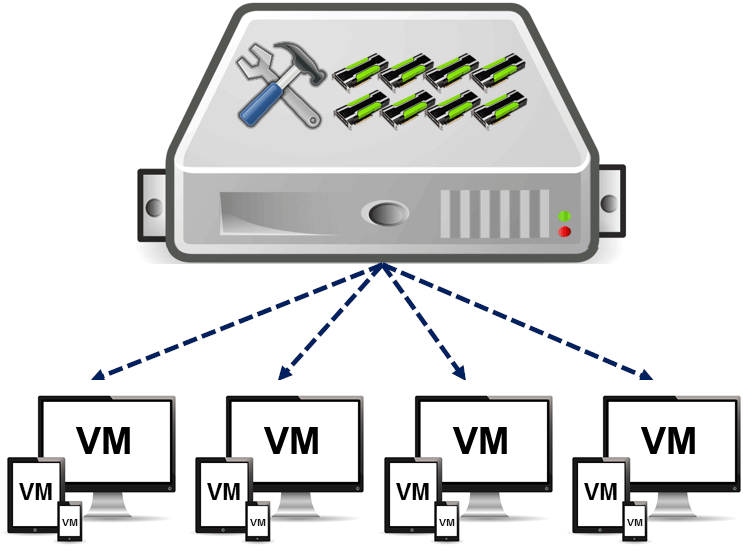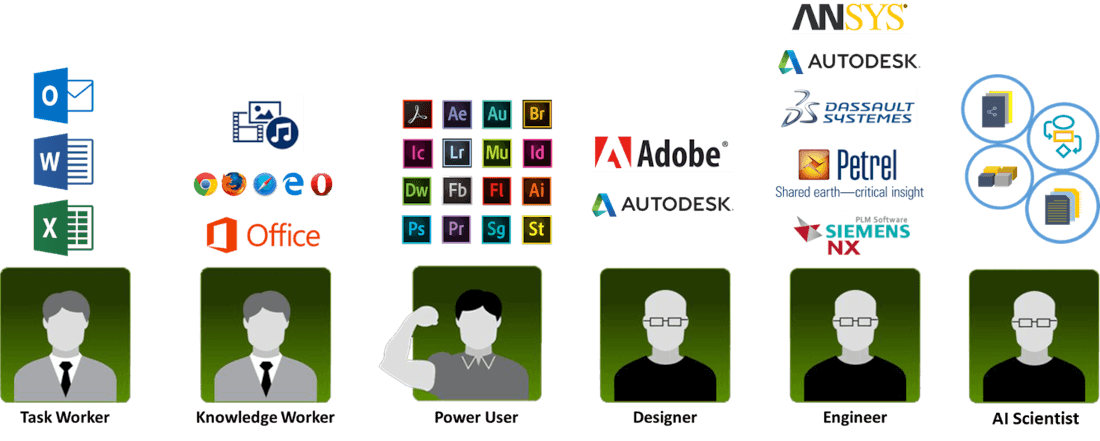GIGABYTE VDI Solution with Virtual GPU
Remote workstations by GIGABYTE deliver an exceptional user experience using VDI paired with vGPU technology
Download White Paper
Introduction
The time is now for Virtual Desktop Infrastructure (VDI) using Virtual GPUs (vGPU) to take hold. Workers and devices are scattered, and employees often need to work remotely. This poses all sorts of challenges in terms of security, productivity, user adaptation, and IT management. Also, there is a shift to a greater need for engineers and designers to use 3D applications and other graphics accelerated applications with large amounts of data. In the past, CPU-only VDI environments were deployed to centralize management; however, these solutions could only reach office workers who did not need graphics acceleration, and power users, designers, and more were left out and had to stick with dedicated machines. Now, VDI has reached the point that all users who need graphics acceleration have a solution by combining VDI with vGPU. GIGABYTE has many servers specifically designed for VDI usage for productivity applications, 3D modeling, HPC applications, AI, and more.
Who needs VDI with Virtual GPUs?
Virtual Workforce
Workforce is shifting, and workers are more commonly needed to do work outside of the office. They also may have to use multiple devices, including tablets or personal phones. VDI allows users to access files remotely, while IT can securely manage the security and privacy concerns.

AI and Deep Learning
Artificial Intelligence and Deep Learning rely on the power of GPUs because most algorithms are parallelizable, which GPUs excel at, and GPUs have incredible memory bandwidth that can handle a lot of data.

Engineering & Sciences
To optimize and test designs in aerodynamics, as well as thermal simulations, these situations require the acceleration that only a GPU can offer. Engineers need access to data or high computing, and with Virtual GPUs the work is possible at a terminal separate from where the data or hardware is based.

Challenges to VDI
Several industries have been quick to adopt VDI, such as Healthcare as they needed greater compliance with regulations, and remote access became a must. However, as companies are pondering the possibility of switching there servers to VDI there are some major challenges ahead.
When we say companies need to adopt new practices we are focusing on the individuals. The switch from a personal device that is always yours to one that is simply logged in can make many users become perturbed. Add this to the fact that not all applications can be virtualized and you have a user that does not want to adopt a new way of using the PC. Convincing and showing employees that in the long term it is worth it must be done. As well, costs upfront are high for VDI architecture. Instead of buying a laptop when a user needs one, all the hardware and setup for VDI must be done before deployment of virtual devices. Last, to deploy virtual devices, IT administrators need to be onboard with the project and require high proficiency in working with servers and may need training. If these challenges can be met companies can reap the benefits of VDI.
Benefits of VDI
User Experience
Resources can better be tailored to user. As well, PC upgrades and repair takes minutes instead of hours.
Productivity & Flexibility
A dedicated, virtualized machine allows users to easily access their work-related resources from anywhere and on any device with internet.
Ease of Management
One central server location to upgrade hardware or software, as well as monitoring and patching, makes IT admins job easier.
VDI Architecture Explained
The concept of VDI is to use hardware in a server and allocate it to virtual machines (VM). The image on the right visualizes the allocation of resources. And the image below depicts virtualization architecture that is discussed next.
To start, a server is built with typical hardware (CPU, RAM, storage, GPU, network interconnects, etc.) that has been determined for the end users. After hardware installation, a hypervisor (Microsoft Hyper-V, Citrix XenServer, etc.) is installed to abstract the hardware. This hypervisor creates a virtualization layer upon which the VMs are built. The hypervisor that is between the VMs and the hardware contains a Virtual Machine Manager. Through this technology each VM is added with their own operating system and applications. At this point a server has virtualized all but the GPU.
To start, a server is built with typical hardware (CPU, RAM, storage, GPU, network interconnects, etc.) that has been determined for the end users. After hardware installation, a hypervisor (Microsoft Hyper-V, Citrix XenServer, etc.) is installed to abstract the hardware. This hypervisor creates a virtualization layer upon which the VMs are built. The hypervisor that is between the VMs and the hardware contains a Virtual Machine Manager. Through this technology each VM is added with their own operating system and applications. At this point a server has virtualized all but the GPU.
To create a virtual GPU, software such as NVIDIA Virtual GPU Manager installs in the hypervisor. This software coupled with other NVIDIA software (vCS, vDWS, vPC, or vApps) allows customization of the virtual machine. On this vGPU layer are the VMs as before, but now with NVIDIA drivers and binaries/libraries.

Virtual Machines from a Single Server

Virtualization with and without a Virtual GPU
Determine the GIGABYTE server and NVIDIA Solution
Details below are meant to help one decide on what solution fits best.
・Understand the types of users to select the appropriate NVIDIA Virtual software
・Learn about the different types of NVIDIA GPUs based on specifications and usage
・Choose from the list of GIGABYTE servers that are NVIDIA vGPU certified
・Understand the types of users to select the appropriate NVIDIA Virtual software
・Learn about the different types of NVIDIA GPUs based on specifications and usage
・Choose from the list of GIGABYTE servers that are NVIDIA vGPU certified
Types of VDI Users
Task Worker:
Basic tasks and do not need graphics acceleration.
NVIDIA Virtual Software: vApps
NVIDIA GPU Used: Turing T4 and
Knowledge Worker:
Entry-level graphics.
NVIDIA Virtual Software: vPC or vDWS
NVIDIA GPU Used: Turing T4 or A16
Power User:
Mid-level graphics to high.
NVIDIA Virtual Software: vDWS or vCS
NVIDIA GPU Used: RTX6000, A10 or Turing T4
Designer, Engineer, AI Scientist:
High-end computing.
NVIDIA Virtual Software: vCS
NVIDIA GPU Used: A100, A30, RTX A6000, or Turing T4

Programs Used by Worker Type
| NVIDIA Accelerators for Virtualized Compute Server Environment | ||||||||
|---|---|---|---|---|---|---|---|---|
| NVIDIA Models | A10 | A16 | A30 | A40 | A100-80G PCIe | RTX A6000 | T4 | |
| Architecture | Ampere | Ampere | Ampere | Ampere | Ampere | Ampere | Turing | |
| CUDA cores | 9216 | 10240 | 3584 | 10752 | 6912 | 10752 | 2560 | |
| Single-Precision | 31.24 TFLOPS | 34.712 TFLOPS | 10.320 TFLOPS | 37.4 TFLOPS | 19.5 TFLOPS | 38.7 TFLOPS | 8.1 TFLOPS | |
| GPU Memory | 24GB GDDR6 | 4x 16 GDDR6 | 24GB HBM2 | 48GB GDDR6 | 80GB HBM2e | 48GB GDDR6 | 16GB GDDR6 | |
| Memory Bandwidth | 600 GB/s | 4x 231.9 GB/s | 933 GB/s | 695.8 GB/s | 1935 GB/s | 768 GB/s | 320 GB/s | |
| Interface | PCIe Gen 4 | PCIe Gen 4 | PCIe Gen 4 | PCIe Gen 4 | PCIe Gen 4 | PCIe Gen 4 | PCIe Gen 3 | |
| Max Power | 150W | 250W | 165W | 300W | 300W | 300W | 70W | |
| Form Factor | single-slot | dual-slot | dual-slot | dual-slot | dual-slot | dual-slot | single-slot | |
| Support NVLink | No | No | No | No | PCIe (NVLink Bridge) | NVLink Bridge | No | |
| Usage | Mainstream graphics and video with AI | VDI applications (support 64 online users) | HPC, AI, data analytics, and mainstream compute | Mainstream visual computing | Ultra-high-end rendering, 3D design, AI(From FP64 to INT4) and data science | High end visual computing | Entry-level to 3D design and engineering, AI (inference), and data science | |
| GIGABYTE Servers (NVIDIA vGPU Certified) | ||||||||
|---|---|---|---|---|---|---|---|---|
| NVIDIA Models | A10 | A16 | A30 | A40 | A100-80G PCIe | RTX A6000 | T4 | |
| 1U G-series | G191-H44 | G191-H44 | G191-H44 | G191-H44 | G191-H44 | G191-H44 | G191-H44, G180-G00 | |
| 1U OCP-series | - | - | - | - | T182-Z70 | - | T181-G23, T181-G24, T181-Z70 | |
| 1U E-series | E152-ZE0 | - | - | - | E162-220 | - | - | |
| 2U G-series | G242-Z11, G291-280, G291-281, G292-2G0, G292-Z24, G292-Z40, G292-Z43, G292-Z44 | G242-Z11, G292-Z24, G292-Z40, G292-Z44 | G291-280, G291-281, G292-Z24, G292-Z40, G292-Z44 | G241-G40, G242-Z11, G292-Z24, G292-Z40, G292-Z44, G292-280 | G292-280, G292-Z40, G292-Z44, G291-Z40, G241-G40, G242-P31, G242-Z11, G291-281, G291-Z40, G242-P32, G292-Z20, G292-Z24 | G242-Z11, G291-280, G292-Z20, G292-Z40, G292-Z44, G292-Z45, G292-280 | G291-280, G291-281, G291-2G0, G291-Z20, G221-Z30, G241-G40, G242-Z10, G242-Z11, G242-P31, G291-Z20, G292-Z20, G292-Z24, G292-Z40, G292-Z42, G292-Z43, G292-Z44, G292-Z22, G292-Z42 | |
| 2U R-series | R282-Z96, R292-4S0 | R262-ZA2, R281-3C2, R282-Z93, R282-Z96, R282-Z9, R262-ZA2 | R262-ZA2, R281-3C2, R282-Z93, R282-Z96, R282-Z9, R262-ZA2, R281-G30 | R262-ZA2, R281-3C2, R282-Z93, R282-Z96, R282-Z9, R262-ZA2, R281-G30 | R282-Z93, R282-G30, R281-3C2, R281-G30, R282-Z93, R282-Z96, R292-4S0, | R292-4S0 | R281-G30, R281-3C2, R282-Z93, R281-T95, R282-G30, R282-Z93, R292-4S0 | |
| 2U E-series | E251-U70 | E251-U70 | E251-U70 | E251-U70 | E251-U70 | - | E251-U70 | |
| 2U H-series | - | - | - | - | - | - | H231-G20 | |
| 4U G-series | G482-Z54, G492-H80, G492-HA0, G492-Z51 | G492-Z51, G492-HA0, G482-Z52, G482-Z54, G481-HA0 | G482-Z54, G492-H80, G492-HA0, G492-Z51 | G492-Z51, G492-HA0, G482-Z52, G482-Z54, G481-HA0, G492-H80 | G482-Z54, G492-Z52, G492-H80, G492-HA0, G481-HA0, G482-Z50, G482-Z52, G482-Z54, G492-Z50, G492-Z51 | G481-HA0, G482-Z53, G482-Z54, G492-H80, G492-HA0, G492-Z51 | G481-H80, G481-HA0, G481-HA1, G482-Z50, G482-Z51, G482-Z54, G492-H80, G492-HA0, G492-Z51 | |
Products
1/4
2U GPU Server for Scale-out
Ideal for scale-out deployment in virtualization for GPU-centric workloads. High core count AMD EYPC™ processor and up to 4 GPUs with direct PCIe Gen4 x 16 connection to CPU. Also, 4 x 3.5" SATA and 2 x 2.5" U.2 (Gen 4)
2/4
1U GPU Server for Small Form Factor
Ideal to scale up for 5G network infrastructure or deployment in a small space. Dual Intel Xeon Scalable processors and up to 4 full-length full-height GPUs.
Related Technologies
In simple terms, Cloud Computing is the delivery of computing services to a user or an organization—servers, storage, databases, networking, software, analytics, intelligence and more—over the Internet ("the Cloud"). Cloud Computing is usually provided using virtualization, in where the physical computer hardware is abstracted from the software & applications that are running on that hardware. Cloud Computing services can be provided several different ways, via public, private or hybrid clouds. Public cloud computing is provided by 3rd party service providers (such as Amazon Web Services, Microsoft Azure, or Google Cloud) who own the physical hardware and then sell these resources online via a secure internet connection. In a private cloud, an enterprise builds a cloud within their own data center by running applications on virtual servers that may reside on any number of available physical machines. Hybrid cloud computing is where a mixture of private and public cloud computing services are used together in tandem. As part of RightScale's 2018 State of the Cloud report, an in-depth survey was conducted of 997 IT professionals about their adoption of cloud infrastructure and related technologies, an astonishing 96% of respondents indicated that they run their enterprise's workloads in a cloud – either public, private or hybrid.
Hyper-Converged Infrastructure (HCI) is a software-defined IT infrastructure that virtualizes all of the elements of conventional "hardware-defined" systems, such as compute, networking and storage. HCI is implemented via hypervisor platform, such as VMware vSAN, KVM or Microsoft Hyper-V for virtualized computing, software-defined storage, and virtualized networking. HCI is typically run on standard, off-the-shelf servers equipped with Direct-Attached Storage (DAS).
A Virtual Machine ("VM") is a software file, referred to as an image or an instance, which exhibits the behavior of a physical computer. Much like a physical computer, the VM runs an operating system and applications, and has its own virtual resources, including CPU, memory, hard drives, network interfaces, and other devices. Each VM's virtual resources are then mapped to the real resources on the physical host computer. A VM gives the end user the same experience as they would on the host itself, and single or multiple VMs can reside on the same host. For servers, multiple VMs run side-by-side with a piece of software called a hypervisor to manage them. The use of VMs to meet computing needs especially on the enterprise side is commonly referred to as virtualization.
Bring Your Ideas Faster to Fruition
Email Sales


























